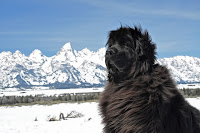 Jeff's choice is a softer look but I kind of lean towards the more alert Sophie. The other image I like is the shot taken from below. The viewer gets a nice sense of her size and she appears very majestic. In all of them, she has this funny spiky hair shooting straight off the top of her head, which is as much a piece of her personality as that dopey hair was on Alfalfa of Little Rascals fame. While it is a bit of a distraction, I wouldn't change it for the world! It is great comic relief.
Jeff's choice is a softer look but I kind of lean towards the more alert Sophie. The other image I like is the shot taken from below. The viewer gets a nice sense of her size and she appears very majestic. In all of them, she has this funny spiky hair shooting straight off the top of her head, which is as much a piece of her personality as that dopey hair was on Alfalfa of Little Rascals fame. While it is a bit of a distraction, I wouldn't change it for the world! It is great comic relief.Thursday, September 29, 2011
Use of a Subject and Background
 Jeff's choice is a softer look but I kind of lean towards the more alert Sophie. The other image I like is the shot taken from below. The viewer gets a nice sense of her size and she appears very majestic. In all of them, she has this funny spiky hair shooting straight off the top of her head, which is as much a piece of her personality as that dopey hair was on Alfalfa of Little Rascals fame. While it is a bit of a distraction, I wouldn't change it for the world! It is great comic relief.
Jeff's choice is a softer look but I kind of lean towards the more alert Sophie. The other image I like is the shot taken from below. The viewer gets a nice sense of her size and she appears very majestic. In all of them, she has this funny spiky hair shooting straight off the top of her head, which is as much a piece of her personality as that dopey hair was on Alfalfa of Little Rascals fame. While it is a bit of a distraction, I wouldn't change it for the world! It is great comic relief.Sunday, September 18, 2011
Difficult Choices

Photographing a black dog is tough - I've said it before and you will hear me say it often. I don't want people to beat themselves up because they are having trouble with this - because we ALL do. I STILL have trouble!
Robin Welter sent in this great shot of Walter, who is owned by Deb and Todd Bridge. (I was really hoping this was Robin's dog, because I just love the name Walter Welter….. Oh, well.)
The photograph has nice color and detail in the background but the dog's side, belly and face are lost in the shadows.
There are a couple things you can do to help counter this situation. First, pop on that flash. Most flashes, especially higher-end ones, will allow you to set the amount of light which it outputs. Flashes normally emit an amount of flash which equals the existing light. This works great if you are photographing someone and want to open up the shadow areas in their eyes. but, to keep the detail in the "black hole" of a wet Newfoundland dog, we need MORE light than the surroundings. So set your flash to one or even two stops OVER exposure. (Check your camera or flash unit's guidebook to see how to do this.)
If you are photographing a water trial, adding a flash may be a distraction to the dog, OR just added weight and bother, so then, you have to make some decisions. Try overexposing your photographs by one stop. This doubles the amount of light entering the camera, which is going to give you the effect of the second photo I've posted here. You have lost some richness in the back and foreground, but your subject is starting to pick up more detail. That's what you want - detail in the dog! You could overexpose by a stop and a half but then you really risk the loss of a lot of background!
Some photo editing programs have a feature called "fill flash." For the third image, I added a bit of this digital fill to the image, which brought Walter out a bit more without sacrificing more of the background. We lost a little more, but not as much as if we'd decreased the exposure another half stop.
Now, in the old days, we'd get this image in the darkroom and begin to "burn" or give additional exposure time to the trees and beach to darken that area - but now, we do that on the computer. Notice how the bottom of this image is blown out? I added a wee bit of shading to bring detail back into that area in the final example.
Then, I popped on a slight darkening that covers all the edges, bringing down the top, sides and bottom and pulling your eye back to the subject, Walter.
Robin has done a great job capturing Walter at work, but, she fell victim to the black dog (black hole!) exposure syndrome.
Do you have a photo you would like me to critique? Please drop me a comment and I'll be glad to take a look. And, thank you to those of you who have sent in other images for me to review. I'm getting to them!
Sunday, September 11, 2011
Beach Party!
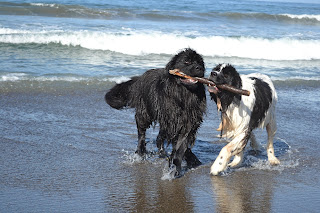
For a true Newf owner, there is nothing better than taking the dog (or dogs) to the beach and enjoying the sheer joy of watching them do what they were born to do - work and play in the water!
Photos of these moments are priceless, and kudos to those of you who go out armed with dogs AND a camera. I have to admit, I tend to focus on the moment and rarely combine play time at the beach with my camera, but that is my loss. For me, it is easier to photograph when I have someone along I can delegate the dogs to, freeing me to focus on shooting, so I rarely mix the two activities.
Carol Stohlgren sent this priceless image of her two dogs, Bo and Storm, playing at a beach near San Simeon CA. She says it is her favorite photo, in part because it captures the two dog's relationship, both with the water and with each other. She uses it for her Facebook page and her computer wallpaper - as well she should! She's captured the two dogs in a wonderful moment of happiness, they are close-up so you can even see the whites of the black newfy's eye, there is wonderful detail in the fur - it is just great!
Are there problems with this image? After studying the image for a while, I realized that there is a black collar or something hanging off the Landseer that I'd like to pick off - but it isn't immediately apparent. And, I suppose a purist would point out lack of detail in the waves - but we aren't shooting for Ansel Adams perfection and when you are photographing a black Newfoundland and the crashing of waves - there is just so much the camera can record. The point is that she got great detail where she wanted it - in her subjects!
Could I improve this image? Oh, I tried. I brought a wee bit more detail into the Landseer's white fur, and I played with actually extending the background a bit so the dogs are in one third of the frame. And I darkened the edges a hair, but honestly - she nailed this in camera - where it needs to be done!
I will give you something to think about, though, if you are taking your dogs out to shoot at the beach, like this. Look for alternate angles. Might there be a more interesting background that doesn't distract from the dogs? (Maybe, maybe not!)
A photo I took last year of Arayo and her pal Gracie in Nova Scotia is very similar to Carol's. I wish I'd been as close to the dogs in my photo as Carol was in her's, but I do like the inclusion of the coastline to give the image a sense of place.
But, everyone's view of the world and of their Newfoundlands is different. Thank goodness! And, much of what I like about photography is trying new things. This blog is to give you a few pointers, and a couple ideas of things to try when you next head out with camera and dog. Carol - thank you for sharing this lovely image with us. Beautiful shot!
Monday, September 5, 2011
Photographing into Trees
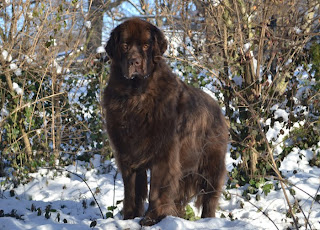
How many times have I heard it - clients who assure me we can do a photo shoot in their backyard because they have all these great trees on their property. I NEVER agree to photograph in a location I've not looked at first, and tend to use the same spots over and over because I know the lighting, the location's assets and its challenges.
Jack Voller sent this beautiful photograph of his girl, Shasta, taken in the snow against a tree-line. His posing is perfect! You get a nice view of her body without it being a full profile, and she is looking right into the camera. Great exposure - you can see lots of detail in the fur.
Jack put thought into his background, avoided just sticking the dog in the driveway and photographing her against the house, the car, the neighbors walking by, etc. But, he has made the mistake we all make when we first begin getting serious about photography and he's backed Shasta right up to the trees. Now, if he were photographing this in the Northwest - you would be hard pressed to find the dog because the trees would be so dark and dense that there would be no contrast between the dog and the trees. (I've discussed how your Newfoundland can become a black hole? Well, same with a dense forest - its like photographing into a cave or a basement - no detail, just black!)
When posed with a situation like this, there are a couple things you can do. First, simply bring the dog forward 20 feet, 30 feet or more and use a shallow depth of field. For those of you just getting into photography - you want to set your aperture at the smallest number possible. That will help to throw the background out of focus. By moving the dog forward, we've also gotten her away from those pesky little branches that are nipping at her. (I used to go to every photo shoot with a bunch of string and little snippers so I could either clip off offending branches or tie them out of the way.)
The second thing to do is to photograph, not INTO the trees but along the tree-line at an angle. Not every place is going to work for this because there may be other distractions, but if Jack had swung Shasta so her rear was about where her shadow is hitting in the snow in this photo, he MAY have found a softer background. Go outside and try it. Look along the tree-line. Get the right angle and the trees become nice texture and not the individual and often distracting units you see when you look directly into the trees.
Had Jack moved Shasta like that for this photo, he also would have changed the lighting. See how Shasta's back is lit by the sun? You see every bit of detail in the fur along the back. So, your eye immediately starts at her face and chest and then keeps wanting to run back to her body which is brighter. Well, had he moved her, her face and chest would be lit more strongly.
Just as an example, I blurred the background to show what it would look like if you'd move her forward or had a very shallow depth of field. I also got rid of the little stick that was nipping at her face. (I'd also like those twigs on the bottom right outta there.) Finally, since there isn't much information on the sides of the shot that is adding anything to the photograph I gave it a square crop and slightly darkened the edges to keep your eye from drifting.
But, none of this photoshop malarkey is a replacement for getting it right in the camera.
Jack, give this another try. You may find this tree-line doesn't work for you because you can't move forward or shooting at an angle has other distractions, but take a look. That's probably 75% of the challenge of photography - finding that perfect location, and it isn't always easy.
Otherwise - fabulous job! She's a gorgeous girl and the photo is almost a masterpiece!
Sunday, August 28, 2011
Tricky Exposures
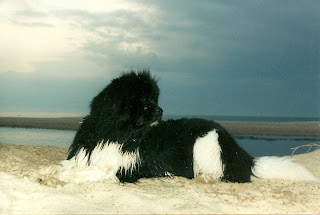
Our Newfoundlands can be tricky little stinkers to photograph. You've all received that Christmas Card or had someone send you a family photo and you know immediately that they have a Newf because there is this big black hole in the middle of the photograph - right? The black fur just sucks up all the light and can be a stinker to work with.
Kim Benedict sent me this image of her Newfoundland, Karma, taken on Lake Michigan. The background is lovely and she has caught a nice quiet moment with the dog. The light is getting low in the sky (see how bright it is off to the left of the frame?) and there is a nice quality of light because of that. Kim has also done what is one of the most important things to do when photographing a dog - she's gotten down on Karma's level. She may actually be laying in the sand to take this image. Good! If you are going to photograph Newfs, just plan on getting filthy!
Even thought the dog is pretty centrally positioned in the frame, I think it is fine. There isn't a lot of detail around to balance off-setting the dog. While basically centered, she is nice and close to the dog without crowding it in the frame.
The problem is that the light behind the dog is quite bright and the camera is exposing for the background, and not the dog. Because she is photographing this black hole, she needs MORE light on the dog! The camera flash has gone off (notice how bright the foreground is?) but it is still not compensating for the brightness of the background.
There are a couple things that can be done to help compensate for the background but they are kind of advanced and frankly, with Newfs, can be iffy, so let's take the easy route! MOVE!
See that stretch of sand behind Karma? How about going out there and positioning Karma so that nicely angled light is now striking the dog? Now the dog AND the background are lit. Move around a bit. You can still pick up sand and water as a background by looking for additional vantage points. (When I photograph at a lake or the ocean, I often have my tall rubber boots on so that I can get out into the water while my subjects are on land.) Kim said that this image was taken near a lighthouse. Hum….. What if the lighthouse was in the background?
WARNING - evening light is fabulous! (morning light not so, because you have to wake up to catch it - grrrrrr…..) but beware of shadows. If you are photographing something that is being struck by low light - you have to position yourself so that your shadow is not in the frame. Just another challenge for you!
I took this image and removed the stick that was at the right of the frame because it was distracting. I have tried to lighten the dog. I've also darkened the edges a bit because it was drawing my eye out of the frame - particularly on the left, but this is a reshoot because the detail isn't there in the dog. Again, Kim did a lot just right with this photograph, it just begs for more detail in the black.
One final point. Karma is watching something off to the right of the frame. I keep wanting to pull her nose just a few inches back toward the camera so we pick up a hint of that other eye and her head doesn't seem to be tilting so far back. But, that isn't a deal breaker - now I'm just being picky, but it is something to think about for a reshoot.
Kim, this really is a beautiful photograph and you were working in a really challenging lighting situation. Take that goofy girl back to the beach and let the light hit her - then you've got it nailed! And, please send in a copy of the new version, okay?
Wednesday, August 24, 2011
A Newfoundland in Newfoundland
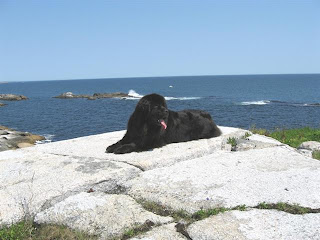
Deanne McNeil lives in heaven - at least she can see if from there…… Well, kinda. From her home in Nova Scotia, she has fairly easy access to Newfoundland - that wicked island that stole my heart and kept it when we visited last year. She asked my opinion on a striking photograph she took of her Newfoundland Dog, Angel, at Rose Blanche, NL.
When I first saw the image I was impressed with it's simplicity. She has carried off something that isn't always easy to do - photographing a Newfoundland on a white rock with water behind it. It can be a technical nightmare.
One thing that sets a "photographer" apart from a casual "snapper" is care with location. Make sure your background is free of clutter - cars, legs, phone poles - these are all things that can distract a viewer from the subject. Dee has done a beautiful job of isolating her subject and she has set Angel in a location where she contrasts nicely with both back and foreground.
Before I continue, a word of caution - ALWAYS photograph using the highest resolution you can. Yes, if you set your camera right you can get a zillion images on one memory card, but they will be too small to crop or enlarge successfully, so get in the habit of shooting large files.
Now, a couple things that might strengthen this particular image. First, move in closer. There is a lot of sky that doesn't give us any information. I use sky in my images if there are impressive clouds, but a little open blue sky can go a long way, so we're going to crop a bunch of that out. This gives the dog more prominence. We haven't lost the significance of the water, but by allowing Angel to occupy more space in the image, it is now more about the dog and less about the vastness of the ocean. While cropping, let's straighten the skyline up a bit.
Second, consider moving the dog off-center. There is a rule called "the rule of thirds" where you divide a frame into thirds horizontally and again vertically. Place your subject where one of these lines converge for the strongest position. Since I liked the texture of the rocks better than the empty expanse of the sky, I placed Angel along the top third of the frame and to the left. Since she is looking to the right of the frame, this gives her room to look off at the world.
Third, our eyes naturally are drawn to what is lightest and since the rock is white and the sky is light - the eye goes to the dog, then wants to drift away and out of the frame. So, I pulled out a program called Lightroom that I use for times like these and put a slight darkening around the edges of the image. This subtly pulls the viewer back to the dog and has the added bonus of adding just a wee bit of texture back into the rocks. Check the computer program you are using - you may have this feature as well.
When I asked Dee what her motivation was behind taking this image she said it was about her Newfoundland at her birthplace and she wanted to pull in the significance of the water. In a perfect world, I'd have taken Angel down to the water's edge, but I know that location and getting to the water is no easy, or safe, task. I think she succeeded in reaching her goal with this shot!
This is a challenging location to photograph. It is rugged and beautiful and sits high above the sea. It is an amazing coincidence that the image I use in the masthead of this blog of Arayo digging around on the rocks - was taken at the same place!
Thanks, Dee, for letting me use your image as an example. Very nice job in a beautiful but tough place to photograph!
Sunday, August 21, 2011
Building Better Photographs
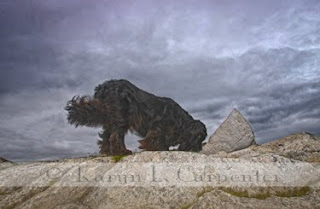
A few years ago I was asked to judge a Newfoundland photo contest. Happy as a pig in mud, I spent a couple hours pawing through images of people's beloved dogs. A great number of the photos went into a thumbs down pile. A couple went into a WOW! pile, and then there were the images in the middle. The "Oh, nuts!" pile.













